The Guitar in Vermeer's Paintings
Vermeer portrayed the guitar only once in his oeuvre, in the late Guitar Player (fig. 1 & 2). "Vermeer's compositional organization of this picture may be linked to his decision to depict a guitar player rather than a lute player. The guitar was just coming into vogue in the late seventeenth century as a popular instrument for solo accompaniment. The music it created was bolder than that of the lute, in large part because its chords produced a resonance not possible on lute which had begun to take on associations with an idealized past, a sophisticated era where music had been enjoyed and contemplated for the purity of its sounds. The bright and direct character of The Guitar Player thus, spoke more to the modern world of music represented by the guitar than to the conservative and contemplative traditions of the lute."Arthur K. Wheelock Jr., Vermeer and the Art of Painting (New Haven: Yale University Press, 1995), 149-150.
Vermeer obviously took great delight in the purely pictorial representation of the instrument as well. This well-known passage can be considered a technical tour de force.The artists paid great attention to the rendering of the decorative black-and-white inlay of its border which creates "staccato" effect that intensifies the painting's crisp, electric atmosphere and lends a rhythmic note consonant to its musical theme. The ornate, hand-carved sound hole is rendered in an astounding calligraphic shorthand of thick blobs of impasto paint, which miraculously describes the way light rakes across its uneven, shiny surface. But perhaps the most subtle technique is reserved for the painting of the instrument's strings. If carefully observed, we find that some of them are strongly blurred to suggest vibration in a quite unconventional manner which finds few parallels in seventeenth-century painting. Thus, Vermeer has painted movement rather than substance.

Johannes Vermeer
c. 1670–1673
Oil on canvas, 53 x 46.3 cm.
Iveagh Bequest, London

Johannes Vermeer
c. 1670–1673
Oil on canvas, 53 x 46.3 cm.
Iveagh Bequest, London
History
There exist various theories about the guitar's origin. Some thought it as a remote descendant of the ancient Greek kithara, suggested by the etymological relationship of "kithara" and "guitar." Others have seen early ancestors among the long-necked lutes of Mesopotamia or in an instrument with curved sides and a flat back represented in a Coptic tomb in Egypt. From the 1st to the fourth century A.C., examples of short-necked lutes with guitar shape were found in Central Asia.
Listen here MP3 audio-file of:
Folias d'Espagne
Gaspar Sanz (c. 1640–c. 1710),
Performed by: Roland Ferrandi
In the early Middle Ages the Arabs (Moors) passing through Egypt on their way to conquer North Africa and Spain, may well have brought with their instruments the cardinal features of the guitar to Western Europe, so that the Arabic influence in Spain prepared the ground for the development of the guitar in Europe. Hence the name "Guitarra Morisca" for a kind of guitar with a long neck, an oval soundbox and several sound holes on its soundboard. It is depicted in the miniatures to Alfonso el Sabio's famous Cantigas de Santa Maria (2nd half of the thirteenth century), together with a "Guitarra Latina" with distinctive curved sides, which has been developed then into the form of the guitar known to us today.
Very important for the spread of the guitar (and other musical instruments) were the many traveling Troubadours in the Middle Ages, who greatly enriched the musical culture on the continent. By the fifteenth century, the four-course guitar emerged as the most popular, but the number of courses (pairs of strings) became more and more variable. In the sixteenth century, the lute had become the favorite instrument of most European aristocracies, except in Spain, where it had been associated with the Moors and their oppressive rule. So, while appreciating the music written for the lute, the Spaniards searched for another instrument and turned to the popular "guitarra" with its four courses. However, this instrument did not possess a sufficiently adequate structure to meet the requirements of complex polyphonic music. Moreover, the Spanish nobles regarded it with contempt seeing it was the instrument of the common people. Thus, the four-course guitar was duly enlarged and got six courses. This new instrument came to be known as the "vihuela" and had its golden age in the sixteenth century. The large type of the vihuela was somewhat longer than the modern guitar, and the neck had twelve frets. Among the more famed vihuela players were Luis Milan (born 1500), Luis de Narvaez and Alonso de Mudarra whose compositions for the vihuela (published in Spanish tablature in 1535, 1538 and 1546) were some of the finest instrumental compositions of the Renaissance.
Sixteenth century guitars were much smaller than the modern guitar (Juan Bermudo described the Spanish guitar in his Declaración de instrumentos musicales 1555 as smaller than the vihuela). This fact is evident in contemporary iconography and by the technical requirements necessary for playing with the left hand as indicated in surviving musical scores. The four-course guitar remained very popular by the common people throughout the seventeenth and eighteenth centuries because its limited range of courses made it useful for playing light dance settings or simple accompanying chords for all the popular songs.

Saint Gallen, Kantonsbibl. (Verdiana), Vad. Slg. P3050]
In a sermon written around the year 1400, Jean Gerson likened the Four Cardinal Virtues in Christianity to the "guiterne de quatre cordes," suggesting that it was a four course instrument at least that early. The earliest surviving music for the four-course guitar appears in the collection for vihuela by Alonso Mudarra (Seville 1546). The earliest Italian source is Melchiore de Barberiis's lutebook of 1549 with four "fantasias" for guitar. Paolo Virchi published the collection Libro de la tabolatura de chitarra in Venice. Above all, music for the four-course instrument flourished in France. Guillaume Morlaye's first guitar book of 1550 is lost, but various of his compositions appeared in a series of guitar books published by the printers Granjon and Fezandat (1552–1555). A concurrent series was published at about the same time in Paris (fig. 3) by Adrian Le Roy and Robert Ballard with music by Le Roy, Grégoire Brayssing and other masters. The repertory in these publications comprises a wide range of material from simple dance settings, intabulations of chansons and psalms to rather fine fantasias, and demonstrates the existence of a true school of guitar playing in France in the sixteenth century.

c.1570

Tobias Stimmer
2nd half of the 16th century
Woodcut, 37.8 x 29 cm.
Albertina graphic collection, Vienna
The five-course guitar (fig. 4, 5 & 6) emerged in the sixteenth century at first in Italy as a development and transformation from the four-course type with the emphasis on brighter, higher-ranged music. It was used both for accompanying the voice and in continuo ensembles.

and the typical 'moustache' at both
sides of the bridge.
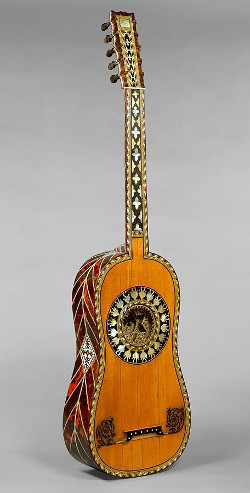
Attributed to Jean-Baptiste Voboam
1697
Decorated with tortoiseshell, ebony and ivory chevrons, framed scrollwork, lozenges and a gilded rossette with mother of pearl edging, 38 1/8 in. (96.9 x 25 cm.
Metropolitan Museum of Art, New York
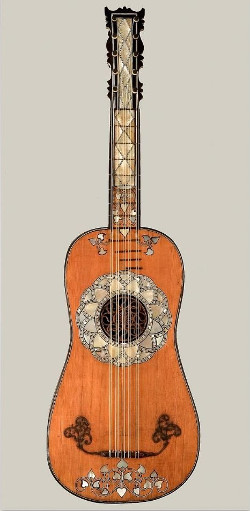
Domenico Sellas
1670
Original spruce belly with inlaid mother-of-pearl, ivory, and ebony. Fingerboard inlaid with incised, mother-of-pearl plaques. Back and sides of snakewood with ivory stringing. Ebony back of neck and peghead heavily inlaid with ivory figures and foliage. Overall length: 84.27 cm. National Music Museum, University of South Dakota

Belchior Dias
1581
Length: 77.1 cm. Width: 19.9 cm.
Royal College of Music, London
Even five-course guitars seem to have been small instruments. One of them, made by Belchior Dias in 1581, is only 76.5 cm. (fig. 7), with a string length of 55.4 cm. Other features of the instrument—shared by other plucked instruments of the period—were an ornamented rose, or rosette, instead of an open sound hole (which later appeared in the nineteenth century), gut frets tied round the neck (usually eight to ten frets) and a lute-type bridge set low on the table. Decorative rosettes were made of parchment vellum (calfskin, goatskin), often several layers deep, similar to an inverted wedding cakes. Some can get immensely elaborate.The tuning was usually E-B-G-D-A, similar to five strings of the modern guitar. The difference was that the fifth course of the Baroque guitar was not really a bass string.
A derivative of the five-course guitar was the "chitarra battente;" which was developed in the mid-eighteenth century. It is characterized by a slightly vaulted back instead of the flat one, which was often decorated with stripes of ivory or other decorative material. Its popularity (it seems to have been used primarily for folk music) is attested to by its frequent representation in paintings.
From Italy, the popularity of the five-course guitar spread throughout Europe during the seventeenth century. Its popularity brought an increasing number of professional guitarists to demand compositions of greater complexity and more refined style. With further developments in playing technique, many talented performing guitarists had become composers and teachers as well.
One of the most important guitarists in that time was the Italian Girolamo Montesardo (fl. 1606–c. 1620), whose work is an illustration of guitar music in the early seventeenth century. But the most talented of all was Francisco Corbetta (c. 1615–1681) who worked at the Royal court of Louis XIV in Paris as well as at the Royal court of Charles II, himself an enthusiastic guitar performer. in London. He dedicated one of the two different editions of his Guitare Royalle (1671 and 1674) to each of these kings. Corbetta's presence in the Netherlands is attested by the publication of his Varii scherzi di sonate per la chitara spagnola in Brussels 1648. One of his many pupils was probably the French Robert de Visée (c. 1650–1732/33) who succeeded Corbetta at the French court and was formally appointed guitar teacher to the king in 1719. Visée's Livre de guitare dédié au roy (1682) and Livre de pièces pour la guitare (1686) mark the high point of French Baroque guitar literature. Visée also produced a collection of excellent pieces for theorbo and lute.
The greatest Spanish guitarist was the priest Gaspar Sanz (c. 1640–c. 1710). Early in his life he received a Bachelor of Theology degree from the University of Salamanca and later went to Italy to study music. In Naples, he became an organist and afterward studied the guitar and became acquainted with the works of Foscarini, Granata and Corbetta in Rome. His three-volume work Instrucción de música sobre la guitarra española (fig. 8), which appeared in eight editions between 1674 and 1697, was the most comprehensive guitar manual of its time. It was enormously popular, particularly in Spain. It included about 90 compositions, most of them dance pieces in the Spanish or Italian style.
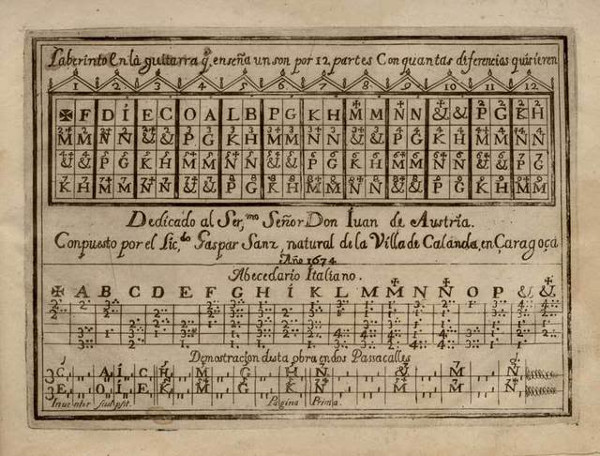
In Northern Europe, the guitar achieved the greatest popularity in Germany. Before long, an impressive number of guitarists and composers were able to rival the Italians, especially in the eighteenth century. The first German composers were Heinrich Schütz (1585–1672) and Samuel Scheidt (1587–1654), followed later by Johann Pachelbel (1653–1706) and Johann Sebastian Bach (1685–1750), with whom the German Baroque music reached a culminating point.
Structure
The typical form of the guitar with its incurved sides is similar to that of the fiddle and may point to an earlier bowed form of a lute which appeared in eleventh-century Byzantine miniatures. The back of the "normal" guitar is flat. Along the fingerboard are complete gut frets tied round the neck. The bridge is similar to that of the lute, fixed on the table and with a typical decoration in form of a "moustache" at both sides. The strings were normally made of gut. From the fifteenth to the eighteenth century, the sound hole appeared as a decorated rose, then it was open, like at the modern guitar. Average measurements of the Baroque guitar were an overall length of about ninety-two cm and a string length of 63–70 cm.
Most of the guitar music called for the characteristic "re-entrant-tuning"with various modifications for the tuning of the respective courses, depending on the style of the music. Thus, it was up to the player to decide which variety of possible tunings and stringings was suitable for each source of music, and this was not always easy.
Guitar Tablature
Guitar music from the period was usually noted in various kinds of tablature, according to that for the lute. The earliest notation specifically for the five-course guitar seems to have appeared in an Italian manuscript of 1580 containing the top parts of madrigals and canzonettas from various composers such as Marenzio and Vecchi. An important innovation was introduced by Girolamo Montesardo in his Nuova inventione d'intavolatura (1606), although the system was used in at least one earlier source of song manuscripts, dated 1599 (Chigiani). In Montesardo's system each left-hand finger position for the twenty-seven most usual chords was denoted by a single letter of the Italian alphabet, hence the name "abecedario italiano" or "alfabeto Montessardino." In five-line Italian tablature the symbols were arranged above or below a horizontal line, where "above" meant a chord struck upwards, and "below" a chord struck downwards. Note values were shown by capital or small letters or by spacings between the dashes. Sometimes the horizontal line was broken up into a number of short equal segments, each representing a bar of music. Numerous modifications, additions and improvements were made by the leading seventeenth century guitar players like Foscarini, Millioni or Sanz. The most important improvement was the introduction of symbols for discords. The system was obviously easy to learn and very cheap to print, and a considerable amount of music in "alfabeto"is still extant, most of them from the seventeenth century. After 1750 guitar music was written in conventional staff notation, an octave above the sounding pitch.
Playing Technique
In the performance of polyphonic music, the technique of playing the guitar was similar to that of the lute: the right hand was supported by the little finger resting on or near the bridge, and the strings were plucked by the thumb and the first two fingers. Such a position was made possible by the low height of the strings over the table.
The repertory of the Baroque guitar required a mixture of techniques, plucking the strings individually was called in Spain "punteado" (Italian "pizzicato," French "pincé"). Strumming of chords by sweeping the hand back and forth over all the strings at once was called "rasgueado" (Italtian "battuto" or "battente", French "batterie"), providing a piece with a particular character. A ringing melodic passage-work was called "campanelas."
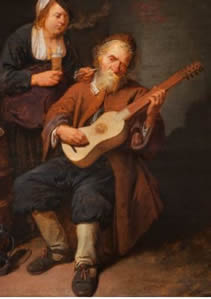
David Rijckaert
1641
Oil on canvas, 52 x 47 cm.
Bredius Museum, The Hague
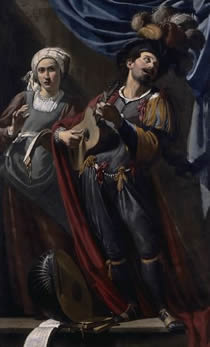
Theodore Rombouts
c. 1616–1625
Oil on canvas, 200 x 121.3 cm.
Spencer Museum of Art at the
Lawrence University of Kansas
A new style of guitar music began to appear with Giovanni Paolo Foscarini's second and third book (1629). Although one of the chief assets (and a true idiom of the guitar) was its ability to play block chords in a rhythmic strumming style, Foscarini adapted the lute technique in combination with the strummed chords to create a mixed style of solo guitar playing. This new mixed style was used then by the finest guitar composers of the seventeenth and early eighteenth century, and it was A. M. Bartolotti, who produced in his two books of 1640 and c. 1655 the first fully developed, masterful examples of this new style, which were some of the finest Baroque guitar music of the seventeenth century.
Until new research was published in 2008, few details about the life of the Spanish guitarist and composer Santiago de Murcia (1673–1739) were known, although he was one of the leading composers of his day and among his country's finest guitarists and pedagogues, as well. "His surviving works were all written for the five-course Baroque-style guitar, which has nine strings; one on the first course and two each on the remaining ones. Murcia was born around 1682, probably in Madrid. Little is known about his early years, though it is believed he had a brother, Antonio, who was a guitar-maker. Around the age of ten, Santiago likely began studying with master guitarist and teacher Francisco Guerau, who had connections to the highest royal circles in his directorship roles at the royal choir school and royal chapel in the 1690s. Murcia himself secured a post at the Spanish Court in the early 1700s as the Queen's guitar teacher. The aforementioned Antonio de Murcia also worked for the Queen (María Luisa Gabriela) as her guitar maker. In 1729, he signed a declaration of poverty and died in Madrid in 1739."Robert Cummings, "Santiago de Murcia: Artist Biography," ALLMUSIC, access no longer available.
The fandango, as a lively and often sensual Spanish dance, was indeed controversial in its early days, particularly during the 18th century. Its rhythmic intensity, suggestive movements, and popularity in taverns and public gatherings sparked moral outrage among certain segments of society, including clergy and conservative elites. These groups viewed the dance as provocative and a potential catalyst for immoral behavior.
In Spain, as well as in other parts of Europe where the fandango spread, critics argued that its energetic music and accompanying dances stirred excessive emotion and passion, leading to disorderly conduct or even debauchery. The dance’s origins in folk traditions, as well as its perceived connections to Afro-Caribbean and Moorish influences, likely contributed to its "exotic" and "dangerous" reputation. The fandango was performed in social settings where boundaries between classes and genders could blur, further fueling concerns about its effect on propriety and decorum.

Some reports suggest that authorities or church officials occasionally attempted to ban the fandango or suppress its performance in public venues, particularly in religious settings where it was deemed inappropriate. However, such measures were rarely successful, as the dance’s popularity only grew. Ironically, the very traits that made the fandango controversial—its rhythm, passion, and improvisatory nature—are what ensured its lasting appeal and influence. Over time, the fandango evolved, becoming part of both classical compositions (as in Santiago de Murcia’s arrangements) and traditional folk repertoires.
The controversy surrounding the fandango illustrates how music and dance can challenge societal norms and act as a flashpoint for cultural and moral anxieties. Its eventual acceptance and adaptation into more formal contexts also show how once-controversial art forms can become celebrated as cultural heritage.
The fandango as a dance and its accompanying music share a close relationship, with the guitar playing a central role in providing its rhythmic and harmonic foundation. The guitar's rasgueado (strumming) and punteado (plucking) techniques emphasize the dance’s lively, syncopated rhythms and its improvisatory character, making it an ideal instrument for the fandango. This connection between the guitar and the fandango not only helped popularize the dance but also established the guitar as a key instrument in Spanish folk and Baroque traditions.
"The Fandango dance boasts a rich and intricate history deeply embedded in Spanish culture. Its beginnings, although somewhat debated, offer a captivating journey through time and regions. The earliest mentions of Fandango can be traced back to the 18th century, with some literature references as early as 1712. The dance’s name, 'Fandango,' is believed to have been derived from the Andalusian term 'fandanguillo,' which translates to 'little dance.' The music is typically played with guitars, castanets, and handclaps, creating a vibrant soundscape that drives the dance. The time signature can vary, but a common form is 3/4 or 6/8, giving the dance a distinctive triple feel.
"The dance is usually performed by a couple, often in a close embrace. The movements are graceful and fluid, with intricate footwork and expressive arm and hand gestures. The dance can be improvisational, allowing the dancers to communicate and respond to each other’s movements.
The Fandango has various regional forms, each with its distinct style and flavor. For example, the Fandango de Huelva is known for its playful and lively nature, while the Fandango de Málaga has a more solemn and introspective quality. These regional variations enrich the dance’s diversity and reflect the local cultures and traditions."Isabella Garcia, "Fandango: Spain’s Passionate Rhythm," VAMOS Buenos Aires, August 9, 2023, Accessed January 23, 2025.
The most famous guitar players and composers of that period, Corbetta, Foscarini and Sanz, treated in various books also the aspects and problems in guitar continuo playing. In addition to devising accompaniments from the harmonic indications of the "alfabeto," the seventeenth-century guitarists had also to learn to read and improvise a continuo accompaniment from the bass line (both with and without figures). Although the Baroque guitar was often unable to sound the true bass note because of its tunings, an idiomatic continuo accompaniment could be realized for the proper harmonies. The most thorough and extensive instructions were given by Nicola Mattei in his Le false consonanse della musica (c. 1680) and later in the English version The False Consonances of Musick (1682). This tutor for guitar continuo playing is one of the most useful and detailed of any seventeenth-century continuo treatise for any instrument, including keyboard.
Guitar Resources:
- Heck, Thomas F., Harvey Turnbull, Paul Sparks, James Tyler, Tony Bacon, Oleg V. Timofeyev, and Gerhard Kubik. "Guitar." Grove Music Online. Published in print January 20, 2001. Published online 2001.
- Dart, Thurston, revised by John Morehen and Richard Rastall. "Tablature." Grove Music Online. Published in print January 20, 2001. Published online 2001..
- Ferrandi, Roland. "The Baroque Guitar." Accessed November 23, 2023.
The Guitar on the Web:
- Guitar Foundation of Amerca (also containing addresses of Guitar Societies worldwide). Accessed November 23, 2023.
- Classical Guitar Illustrated History, Accessed November 23, 2023.
Composers:
- Giovanni Paolo Foscarini (c.1600–1650), I quattro libri della chitarra spagnola (c. 1635)
- Francesco Corbetta (1615–1681), Varii scherzi di sonate, Libro 4 (c.1648)
- Angelo Michele Bartolotti (c. 1615–1680)
- Giovanni Battista Granata (1620–1687)
- Gaspar Sanz (c. 1640–1710), Instrucción de música sobre la guitarra española (1674)
- Robert de Visée (c. 1658–1725), Livre de guittarre dédié au roy (1682), Livre de pièces pour la guitare (c. 1686)
- Ludovico Roncalli (1654–1713), Capricci armonici sopra la chitarra spagnola (1692)
- Francisco Guerau (1649–1722), Poema harmonico (1694)
- Henri Grenerin (fl. mid-17th century)
- Santiago de Murcia (c. 1673 – 1739), Resumen de acompañar la parte con la guitarra (1714), Cifras selectas de guitarra (1722), Códice Saldívar No.4 (c. 1730) , and Passacalles y Obras (1732)